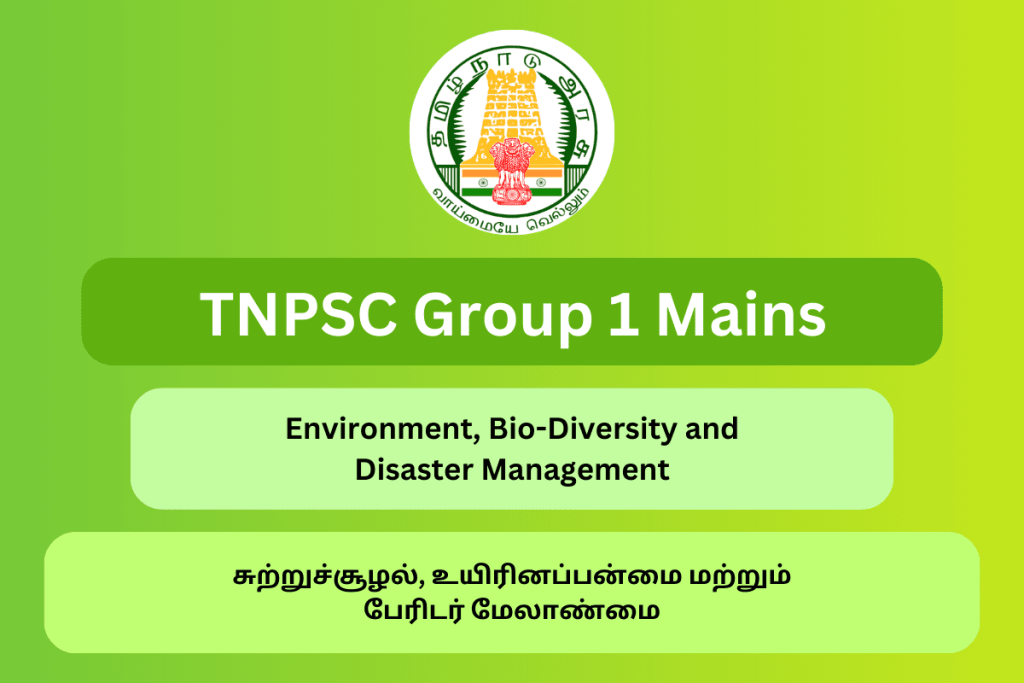Exploring Environment, Bio-Diversity, and Disaster Management: TNPSC Group 1 Mains Paper 4
The TNPSC Group 1 Mains examination is a significant milestone for aspirants aiming to serve in administrative roles within Tamil Nadu. TNPSC Group 1 Mains Environment Paper 4 of the examination encompasses the examination of Environment, Bio-Diversity, and Disaster Management, reflecting the importance of environmental conservation and disaster preparedness in sustainable development. In this detailed article, we will delve into the syllabus and provide effective strategies for aspirants to prepare comprehensively for this section.

TNPSC Group 1 Mains Syllabus based Topic-wise Study Materials Paper 4
The syllabus for Environment, Biodiversity, and Disaster Management in TNPSC Group 1 Mains can be broadly categorized into three sections:
| Environment, Bio-Diversity and Disaster Management சுற்றுச்சூழல், உயிரினப்பன்மை மற்றும் பேரிடர் மேலாண்மை |
- Indian Economy & Impact of Global Economy on India – TNPSC Group 1 Mains
- Geography of India with Special Reference to Tamil Nadu – TNPSC Group 1 Mains
TNPSC Group 1 Mains Environmental Issues
- Environmental pollution (air, water, soil, noise) and its causes and consequences
- Climate change and its impact on India (global warming, sea level rise, extreme weather events)
- Deforestation, land degradation, and desertification
- Waste management and sustainable practices (3Rs – Reduce, Reuse, Recycle)
- Environmental conservation strategies and policies (e.g., National Biodiversity Action Plan, Forest Conservation Act)
TNPSC Group 1 Mains Biodiversity
- Importance of biodiversity and its role in maintaining ecological balance
- Threats to biodiversity (habitat loss, poaching, invasive species)
- Conservation efforts in India (protected areas, wildlife sanctuaries)
- Biodiversity hotspots in India (e.g., Western Ghats, Eastern Himalayas)
- International conventions and agreements on biodiversity (e.g., Convention on Biological Diversity)
| Environmental Pollution and Management: Air, Water, Soil, Thermal and Noise Pollution and Control Strategies – Solid and Hazardous Waste Management – Environmental Impact Assessment (EIA): Steps in EIA Process – Environmental Clearance – Environmental Auditing – Climate Change: Global Environmental Issues and Management – Changes in Monsoon Pattern in Tamil Nadu and India – Environmental Consequences of Climate Change and Mitigation Measures – Clean and Green Energy – Environmental Sustainability சுற்றுச் சூழல் மாசுபாடு மற்றும் மேலாண்மை : காற்று நீர், மண், வெப்பம் மற்றும் ஒலி மாசுபாடு மற்றும் கட்டுப்பாட்டு உத்திகள் – திடக்கழிவு மற்றும் அபாயகரமான கழிவு மேலாண்மை – சுற்றுச்சூழல் தாக்க மதிப்பீடு (EIA) : சுற்றுச்சூழல் தாக்கத்தினை மதிப்பிடும் செயல்முறைகளின் படிநிலைகள் – சுற்றுச்சூழல் அனுமதி – சுற்றுச் சூழல் தணிக்கை – காலநிலை மாற்றம் : உலகளாவிய சுற்றுச்சூழல் பிரச்சினைகள் மற்றும் மேலாண்மை – தமிழ்நாடு மற்றும் இந்தியாவில் பருவ மழை கால மாற்றங்கள் – காலநிலை மாற்றத்தினால் சுற்றுச் சூழலில் ஏற்படும் விளைவுகள் மற்றும் தணிப்பு நடவடிக்கைகள் – தூய்மை மற்றும் பசுமை ஆற்றல் – சுற்றுச்சூழல் நிலைத்தன்மை | 11th Std – Chemistry – [ Environmental Chemistry ] | 11th Std – இயற்பியல் – [ சுற்றுச்சூழல் வேதியியல் ] |
| 12th Std – Economics – [ Environmental Economics ] | 12th Std – பொருளியல் – [ சுற்றுச்சூழல் பொருளியல் ] |
TNPSC Group 1 Mains Disaster Management
- Types of natural disasters in India (e.g., cyclones, earthquakes, floods, droughts)
- Disaster preparedness, mitigation, and response strategies
- Role of National Disaster Management Authority (NDMA) and State Disaster Management Authorities (SDMAs)
- Disaster risk reduction and community awareness programs
- Importance of early warning systems and evacuation plans
TNPSC Group 1 Mains Effective Preparation Strategies: Environment, Bio-Diversity, and Disaster Management
- Reference Materials: Utilize standard textbooks on environmental science, biodiversity, and disaster management. Supplement them with government reports (e.g., India’s State of the Environment Report), research papers, and credible online resources.
- Current Affairs: Stay updated on current environmental issues, biodiversity threats, and recent natural disasters in India and globally. Utilize reliable news sources and scientific publications.
- Focus on India: Pay particular attention to environmental challenges and biodiversity conservation efforts specific to India. Analyze government policies and their effectiveness.
- Case Studies: Familiarize yourself with case studies of successful disaster management practices or biodiversity conservation initiatives in India.
- Data and Statistics: Utilize relevant data and statistics to support your arguments about environmental degradation, biodiversity loss, or disaster risk reduction.
- Interconnectedness: Recognize the interconnectedness between these three areas. Environmental degradation can exacerbate disaster risks and threaten biodiversity.
Strategies for Each Section of Paper 4 Environment, Bio-Diversity, and Disaster Management
- Environment: Focus on analyzing the causes and consequences of various types of pollution. Discuss potential solutions and sustainable practices for environmental protection.
- Biodiversity: Explore the importance of biodiversity for ecosystem services and human well-being. Analyze threats and conservation strategies, highlighting relevant national parks and wildlife sanctuaries in Tamil Nadu if applicable.
- Disaster Management: Understand the different types of natural disasters relevant to India and analyze their causes and potential impacts. Discuss mitigation strategies, disaster preparedness plans, and the role of government agencies.
- TNPSC Group 2 Mains – Administration of Union and States & Tamil Nadu
- TNPSC Group 1 Prelims Study Materials for Tamil Nadu – History, Culture and Socio-Political Movements
- TNPSC Group 4 Study Materials for Development Administration in Tamil Nadu
Conclusion on Environment, Bio-Diversity, and Disaster Management
Acing the TNPSC Group 1 Mains exam requires a holistic understanding of environmental issues, biodiversity loss, and disaster management strategies. By strategically utilizing the provided resources, staying abreast of current affairs, and emphasizing the interconnectedness of these areas, you can confidently approach this section and showcase your knowledge and concern for our planet. Remember, a data-driven approach, the ability to analyze case studies, and a focus on India’s specific challenges will be key to excelling in this exam.









